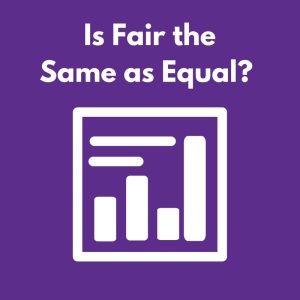In a forum recently, I was asked the question, is fair the same as equal? This is a topic I discuss far too often with my kids so I am well acquainted with this concept!
Fair vs equal is an important question to consider when it comes to how to allocate our very limited resources. In the forum, I answered that no, I do not think that fair is the same is equal.
As I look at the school populations that make up our district, I see that each one is unique and has needs that are different from the others. As we can see with our district’s achievement gap, there is a currently a wide difference in the needs of the students in some of our schools. Thinking in terms of fair vs equal, I believe it isn’t fair if we give equal resources to all our schools. But, how do we determine where to provide more resources?
This spring, a model was developed by administration that aims to quantify where to assign resources. The model weights schools’ need by a formula that includes the number of kids receiving free and reduced lunches, kids that are English language learners, schools with children in three levels of special education, student achievement, mobility rates, and at-risk factors. Is this what people are referring to when they say “move the resources”? This has become a common phrase given as a solution for narrowing the achievement gap. This year the “Weighted Resource Allocation Model” (WRAM) is being used to determine where to place para-educators, clerical staff, and SAMs/Behavior interventionists. The plan is that next year the model will be used to assign certified staff (e.g. teachers) and administrators, although per Mr. Murley, “we may need to slow down that implementation to account for the implementation issues we are starting to encounter.”
“Moving the resources” is one tool that we can use to address our achievement gap, but I believe that we can’t depend on just one solution to address this complicated issue. The WRAM is but one of many tools we can use. Practical boundary changes are another. Creative programming adapted from other districts is another. We need many tools in our toolkit. Overall, I believe that the most important thing is that we move beyond numbers and ask our teachers and principals what their specific population of students need. They are the experts.
The WRAM is a place to start in equalizing our educational environment between our schools. Let’s remember though that it isn’t a silver bullet and we can’t stop there.
